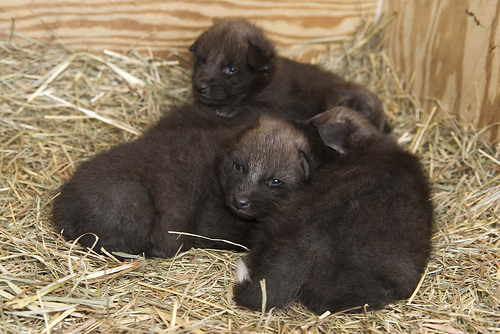Four Maned Wolf Pups Born at the Smithsonian Conservation Biology Institute
Although 2012 has only just begun, the Smithsonian Conservation Biology Institute in Front Royal, Va., already has something to celebrate in the new year: the birth of four maned wolf pups Jan. 5. It is the first litter born at SCBI-FR in two years and will play an important role in helping researchers maintain a viable, self-sustaining population under human care.
Every pup born here helps us understand more about the biology of this incredible species, said Nucharin Songsasen, an SCBI research biologist. SCBI has a long history with the maned wolf, both in terms of studying the biology and maintaining the genetic diversity of individuals living under human care, as well as in conserving the animals in the wild.
The four pups were born to mother, 8-year-old Salina, and father, 4-year-old Nopal, who was born at SCBI-FR. Maned wolf pups have a 50 percent mortality rate in the first month, so keepers are monitoring them closely. This litter is particularly valuable because Nopal is the 10th most genetically valuable male among the 36 reproductively viable males in the Association of Zoos and Aquariums' Maned Wolf Species Survival Plan, which matches animals across the country to ensure genetic diversity in the population. Seventy-two maned wolf pups have been born at SCBI-FR since 1975, and the facility currently has 12 wolves, including the pups. The National Zoo has two maned wolves on exhibit at its Cheetah Conservation Station.
Maned wolves are difficult to breed under human care and in the past five years the North American population has declined 20 percent. Researchers believe that the reproductive challenges are caused, in part, by gastrointestinal disorders that are common in the species and may be linked to diet. As a result, SCBI is one of 19 institutions participating in a study to determine whether a plant-based diet that more closely simulates the diet of maned wolves in the wild boosts reproductive rates. Salina and Nopal are both on the new trial diet.
SCBI researchers have also been working to advance knowledge about the reproductive physiology of maned wolves. They were the first to confirm that, unlike most other canid species, the maned wolf is an induced ovulator, which means that a female needs to be around a male to ovulate. The next step for SCBI is to determine whether the male emits chemical cues that spur ovulation. SCBI researchers are also perfecting the science of maned wolf artificial inseminations so that even behaviorally or reproductively challenged animals can be represented in the gene pool.
To keep a high level of gene diversity, it is important that every genetically valuable individual reproduce, said Melissa Rodden, coordinator of the Maned Wolf Species Survival Plan. SCBI is leading the research on innovative tools that will help us ensure that that will happen.
Maned wolves live in central South America. With approximately 20,000 left in the wild, the species is considered near threatened by the International Union for Conservation of Nature. The species' primary threats include habitat loss and degradation and human conflict. Currently only 20 percent of natural maned wolf habitat remains, and only 5 percent of that habitat is protected.
SCBI is working with researchers in Brazil to look at how human development affects the dynamics and competition for food and territory between three canid species there: maned wolves, crab eating foxes and hoary foxes. Because human–wildlife interactions are one of the main threats to the animals, the end goal of this work is to develop an education and outreach program to mitigate the conflict.
The Smithsonian Conservation Biology Institute plays a key role in the Smithsonian's global efforts to understand and conserve species and train future generations of conservationists. Headquartered in Front Royal, Va., SCBI facilitates and promotes research programs based at Front Royal, the National Zoo in Washington, D.C., and at field research stations and training sites worldwide.
# # #
Photos by: Lisa Ware, Smithsonian Conservation Biology Institute

